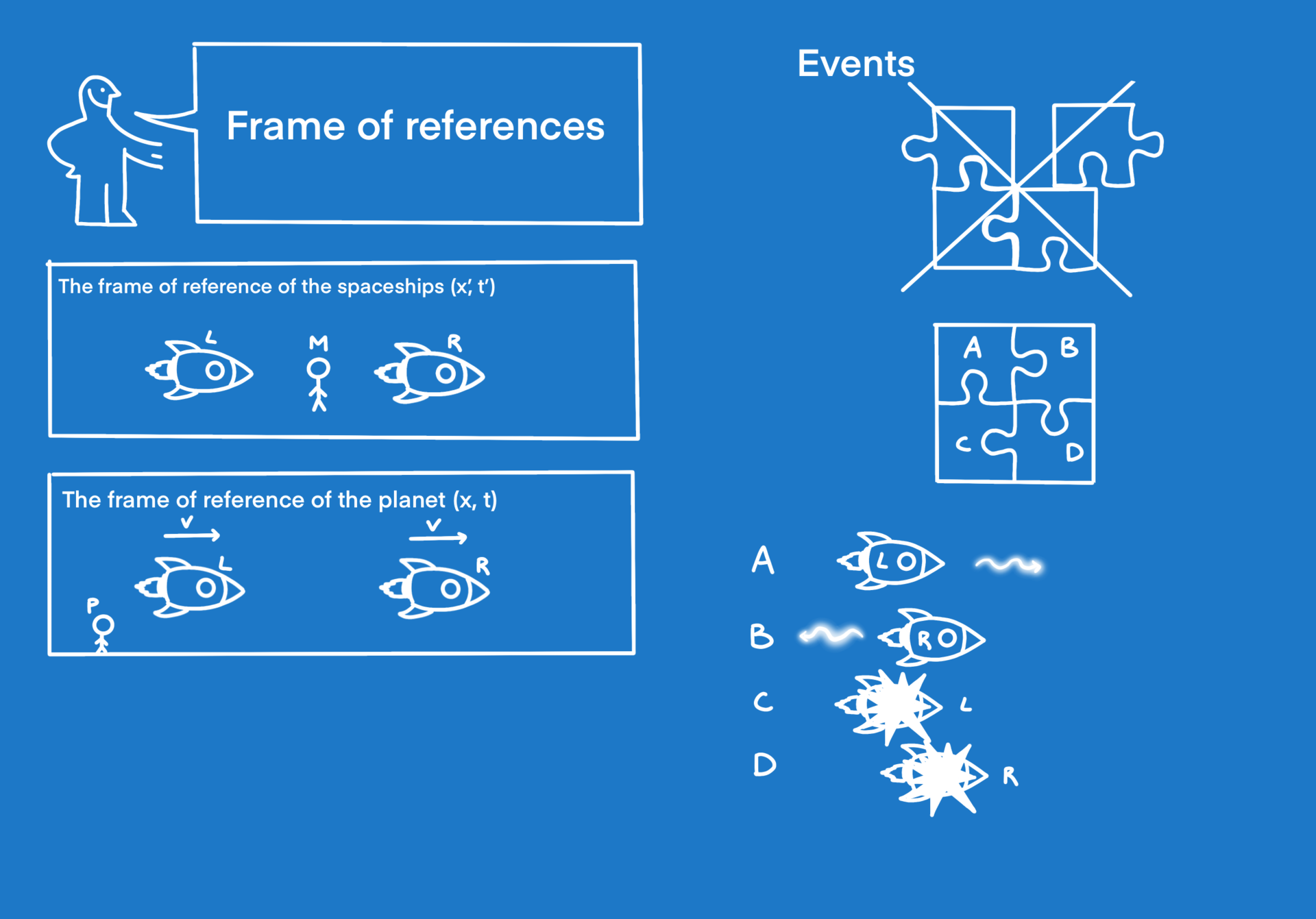Now that we have landed on Lajaland, we want to execute some experiments. More specifically: relativity experiments! (special relativity to be exact)
*me hypnotising you*
You know nothing about relativity.
Our first experiment is spaceship duel, which I will explain in detail soon. The idea behind this exercise is to rediscover what Einstein discovered. No spoilers here, but you may have a hint: simultaneous events.

The spaceship duel involves two spaceships emitting laser beams towards each other to explode each others ships... cruel. During this experiment we will study two frame of references.
The frame of reference of the spaceships (x', t')
In spaceship frame both spaceships has velocity v = 0 relative to each other, aka. standing still. Stationed perfectly in the middle between the two spaceships we have observer M(iddle), take a look at figure 1 for illustration.
The frame of reference of the planet (x, t)
Planet in question: Lajaland. Both spaceships are moving with equal speed v with respect to the ground. Take a look at figure 1 for illustration.
Why is it important to define a frame of reference?
Allow me to explain it like this: You are probably sitting right now (if not... uh... SIT!). Would you say that you are remaining still and not moving? Or would you say that you have a velocity of 1670 km/h? AHA, you are confused now!
In your frame of reference you are sitting still. For a person in space, it looks like you are sitting on earth which spins with a velocity of 1670 km/h. A huuuge difference. Which is why it is important to ALWAYS specify which frame of reference we are looking at.
| Event | What |
|---|---|
| A |
Left spaceship shoots a laser beam towards right spaceship. Event at origin x = x' = t = t' = 0 |
| B | Right spaceship shoots a laser beam towards left spaceship |
| C | Left spaceship explodes due to being hit by a laser beam from right spaceship |
| D | Right spaceship explodes due to being hit by a laser beam from left spaceship |
Note:
Take a look at figure 1 (once again) for very informative illustration of each event :)
Events can be described as points in time t and space x. We differentiate between two frame of references by marks that look like apostrophe, (x, t) and (x', t').
Origin event is when both observers M and on planet decides to set both watches to 0. In this case it is event A.
In spaceship frame, both spaceships simultaneously shoot a laser beam towards towards the other (ONLY SIMULTANEOUSLY IN SPACESHIP FRAME, NOT PLANET FRAME).
We are in planet frame

I am about to make a bizarre statement:
(We are in spaceship frame) Observer M right in the middle of both spaceships, will observe event A and event B simultaneously.
One thing we know for certain, is the speed of light is an invariant size. Meaning the speed of light is the same for all observers in different frame of references.
Does it make sense why M observe both events simultaneously? Try to think very hard and take a look yourself.
Now, event A and B are simultaneous for observer M since she is in the same frame of reference as the spaceship. The question is why must she observe them simultaneously? The laser beams from both spaceship has to travel the same distance to observer M. Since the beams are travelling with the same distance at the same speed (C is invariant), they must arrive at the same time (arrive at observer M). Thus, observer M observes both event simultaneously!
Maybe that wasn't such a bizarre statement. However, it is about to get interesting. Let's switch perspective, literally.
We are in planet frame
We will be looking at it from planet frame. In planet frame, observers are placed on Lajalands surface and observe both spaceships, a well as observer M, moving with a velocity along positive x-axis (with respect to the ground).
There are three things we know:
- we know observer M sees the two light beams crossing just at her position
- the fact that observer M is in the middle between the spaceships
- that the laser beams were emitted simultaneously in the spaceship frame

You may have guessed that what Lajaland observers observe, is not the same as what M observes.
Expect for one thing: both observers will agree that the light beams will cross at the middle position. First thing we knew (from the list above): observer M sees the two light beams crossing just at her position. Due to this, it is not possible for observer M to observe both laser beams simultaneously and not simultaneously.
Karl: Didn't we just specify that event A and B was "ONLY SIMULTANEOUSLY IN SPACESHIP FRAME, NOT PLANET FRAME"? Does that mean one spaceship fired a beam before the other one in planet frame, since the beams still crossed in middle position in both frame of reference?
Rebecca: Correct! But which one fired the first beam?
As a planet observer, the whole spaceship duel is moving with a speed v (figure 3). We will look at the whole duel event-for-event and study what happens.
Shits about to get confusing. Here are some equipment you may need:
Red: left spaceship
Blue: right spaceship
Event A: Left spaceship shoots out a beam towards the right one. The right spaceship looks like it is "running away" from the left beam (both have a velocity pointing the same direction). Therefore, it will take longer time for the beam from left spaceship to reach right spaceship.
Event B: Right spaceship shoots out a beam towards the left one. In this case, the left spaceship moves towards the right beam (both velocities are pointing towards each other). Surprise, it will take a shorter amount of time for the beam from right spaceship to reach left spaceship.
Event C: As a consequence of event B, the left spaceship will explode first (event C)
Event D: Will happen last because left beam arrives at right spaceship after right beam arrives at left spaceship.
TLDR; In planet system events occur in order A, B, C and D. In order for observer M to observe both beams crossing, the left spaceship must fire the beam first (we are still in planet frame).

Is this actually the case or did I just have a completely brain fart?
Yay, we got the right answer!
Karl: That's it? That was what Einstein discovered?
Rebecca: Almost there ;)
We are in planet system still
We can set up equation to study this shit even further. We are interested in when the position of the right beam AND left beam crosses the postion of the middle observer. From these we can derive something very interesting, hint: simultaenously.
Speed triangle is your best friend for setting up these equations ;)
Beginning at time tM with when the two beams cross at the position of middle observer. This is when position of middle observer equals the position of the beam emitted form the leftmost spaceship.
| What | Position |
|---|---|
| Leftmost spaceship | \(x_L (t) = v(t-t_A)\) |
| Observer M | \(x_M(t) = v(t - t_A) + L/2\) |
| Left beam (event A) | \(x_A (t) = t - t_A\) |
More equipment for you. Relativistic units: C = 1
Position of left beam = position of observer M at time tM.
\(x_M (t_M) = x_A(t_M)\)
\(v(t_M - t_A) + L/2 = t_M - t_A\)
(Skipping the algebra. Feel free to try yourself, it is straight-forward)
\(t_A = t_M = - \frac{L/2}{1-v}\)
We found the time for event A!
Now we are interested in when the position of the leftmost spaceship equals the position of the beam emitted from the rightmost spaceship at time tC.
| What | Position |
|---|---|
| Rightmost spaceship | \(x_R (t) = v(t-t_B)\) |
| Right beam (event B) | -\((t-t_M) + L/2\) |
Position of leftmost spaceship = position of the beam emitted from the rightmost spaceship
\(x_A = x_B\)
\(v(t_C - t_M) = -(t_C - t_M) + L/2\)
(Skipping the algebra once again)
\(t_C = t_M + \frac{L/2}{1+v}\)
We found the time for event C!
Karl: So how long does it take from the beam is emitted from the leftmost spaceship at time tA to the time the leftmost spaceship explodes at time tC.
\(\Delta{t}=t_C-t_A = L\left(\frac{1}{1-v^2}\right)\) Planet frame
but in spaceship frame?
\(\Delta{t'}=L\) Spaceship frame
The ratio between the time intervals in planet frame and spaceship frame
\(\frac{\Delta{t}}{\Delta{t'}} = \frac{1}{1-v^2}\)
Just gonna make it look a little nicer
\(\Delta{t} = \frac{1}{1-v^2}\Delta{t'} \)
AHA! So that is why event A and B was simultaneous in spaceship frame only and not in planet frame. Converting from time in one frame of reference to another, can never be the same due to the factor \(\frac{1}{1-v^2}\).
That ladies and gentleman is called time dilation and is what Einstein discovered. The consequence of that was simultaneously is relative. Simultaneous event in one frame of reference is NOT simultaneous in another frame of reference.
Karl: I happen to know a bit about relativity. Are you sure that factor is not supposed to be \(\frac{1}{\sqrt{1-v^2}}\)? The Lorentz factor \(\gamma\)?
Rebecca: Oh no, I must have messed up somewhere in my notes! I can't seem to find the mistake.
Karl: Hmmmm... did you happen to use the distance between both spaceships were L in both frame of reference?
Rebecca: Yes?
Karl: Maybe it's not only time that's fucky wucky when looking at different frame of references... maybe length is also fucky wucky...
